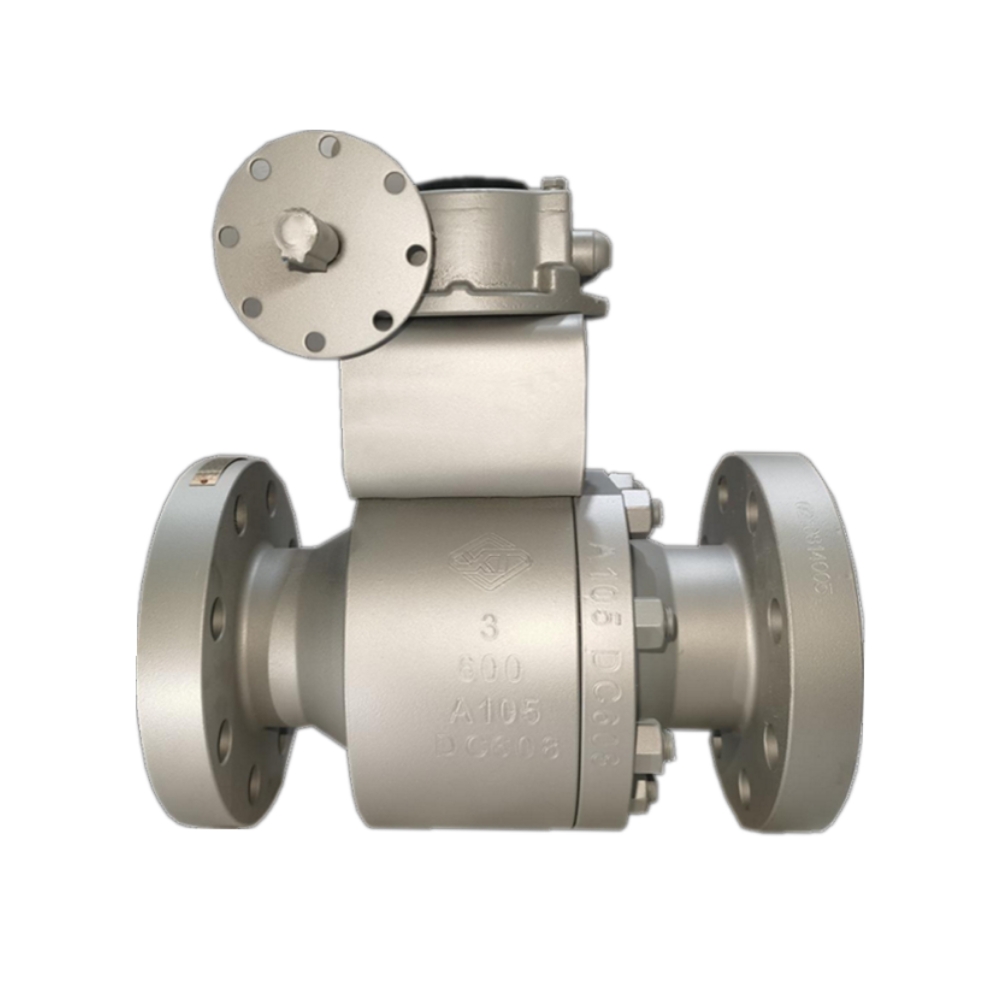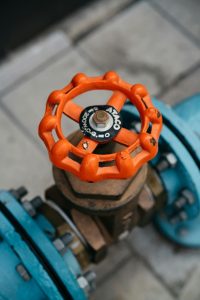Choosing the right type of ball valve is crucial for industrial applications as knowing the difference between a trunnion vs floating ball valve.
Floating and trunnion are the two most common types of ball valves.
Floating ball valves are often used in industrial applications, while trunnion-mounted valves have a fixed ball and can be adjusted to regulate pressure.
Both types can be used to control pressure in industrial and long-distance pipelines.
If you want to know more about the difference between the trunnion and floating ball valves, continue reading this article.
Table of Contents
ToggleWhat to Know About a Trunnion Ball Valve
A trunnion ball valve is a type of pressure-reducing valve. Its three-piece construction features a fixed valve core on the upper stem and a movable sealing seat on the lower stem.
As a result, a trunnion ball valve is more stable in its operation, with excellent shear force, automatic compensation, and self-cleaning features.
In addition, it is ideal for on-off control of suspensions with tiny solid particles or viscous media.
The trunnion ball valve is available in a variety of sizes.
These valves are also more expensive than floating ones. The trunnion mounts the ball, providing adequate backing for the ball.
The trunnion also absorbs extra pressure and stress on the valve seat. As such, the trunnion-mounted ball valve is easy to operate.
Since the ball sits inside the valve seat, it can regulate the flow of liquids in a pipeline. Its dual functionality means that it can be used for petroleum and water pipelines.
In terms of application, the trunnion ball valve is useful in both high and low-pressure applications.
It requires less torque when turning than floating ball valves.
While both styles of the ball valve are equally effective in different types of applications, the trunnion ball valve is more expensive than the floating type.
Advantages of a Trunnion Ball Valve
The trunnion ball valve may have a more complex design than the floating ball valve but it is more reliable and is more durable. Its movable sealing seat is easy to clean, too.
This valve is generally easier to use. Its metal trunnion holds the ball in place.
The ball is suspended in the body of the valve, and downstream pressure pushes the ball against the downstream seat.
The result is a leak-tight seal. In contrast, a floating ball valve uses a floating ball, which is connected to a stem.
Disadvantages of a Trunnion Ball Valve
The drawbacks associated with a trunnion ball valve encompass several factors.
Firstly, the cost can be a limiting factor, as trunnion ball valves may prove more expensive than alternative valve types like floating ball valves.
Maintenance poses another challenge, as repairing trunnion ball valves can be intricate, potentially requiring system-wide halts, which may counterproductively interrupt operations.
Additionally, the size of trunnion ball valves may be a limitation in certain applications due to their bulkiness.
Repairing these valves can be further complicated by their fully welded or bolted-together design, making in-line repairs challenging and potentially causing disruptions to normal pipeline operations.
Neglecting required maintenance could lead to increased friction in welded parts, diminishing efficiency.
Furthermore, trunnion ball valves may have limited suitability for specific applications, particularly those involving corrosive chemicals or high-pressure scenarios.
By comprehending these disadvantages, one can make an informed decision on whether a trunnion ball valve aligns with the specific requirements of their application.
What About a Floating Ball Valve?
A floating ball valve is a simple valve that has a good sealing performance.
The load from the sphere is transmitted to the outlet sealing ring.
The sealing ring should be made of a material that can bear the working load of the sphere medium.
This type of valve is typically used for low and medium-pressure applications.
In a floating ball valve, the ball floats inside the valve. It is not connected to anything. The valve seat is fixed, and the ball is free.
When the pressure changes, the ball moves towards the opening and creates a tight seal to stop the flow.
In this type of valve, the ball is pushed towards the opening to control the flow.
Floating ball valves are often used in multi-port applications.
They are ideal for high-pressure and low-pressure applications, as well as for suspensions containing tiny solid particles.
Advantages of a Floating Ball Valve
Firstly, they boast a lower risk of leakage in comparison to trunnion ball valves, rendering them apt for applications where leak prevention is paramount.
Their maintenance is notably more straightforward than trunnion ball valves, which can be intricate to repair, often necessitating system-wide halts for maintenance procedures.
Cost-effectiveness is another feather in their cap, as floating ball valves generally come at a more affordable price point than their trunnion counterparts.
Their versatility shines through in their compatibility with various fluids, easy operability, and suitability for applications in confined spaces.
Offering a rapid response to shutting off or allowing fluid flow, floating ball valves prove invaluable for emergency shut-off systems and critical applications.
The design featuring a floating ball ensures impermeable sealing when pressed onto its seats, guaranteeing a tight seal and preventing any media from leaking through the valve.
Understanding these advantages empowers decision-makers to assess the suitability of a floating ball valve for specific applications.
Disadvantages of a Floating Ball Valve
Using a floating ball valve comes with certain drawbacks.
These valves find limitations in high-pressure applications, as the elevated pressure during shut-off can accelerate wear and tear on seats and seals.
Repairing the valve can prove challenging if the ball becomes stuck due to certain fluids.
Furthermore, the use of floating ball valves is not recommended for handling thick liquids, as they can accumulate deposits, compromising their efficiency.
Their applicability is also confined to small designs, tailored to manage torque levels, rendering them less suitable for larger applications.
Additionally, the operation of floating ball valves involves high torque during shut-off, contributing to an increased rate of wear and tear on seats and seals.
A comprehensive understanding of these disadvantages is crucial for making well-informed decisions regarding the suitability of a floating ball valve for specific applications.
What is the Difference between Trunnion and Floating Ball Valve?
There are several differences between the trunnion and floating-type ball valves.
In the case of the trunnion, the upper and lower stem are fixed, while the floating valve has a movable ball.
This type of valve features a more stable working condition, self-cleaning function, and automatic compensation feature.
This type of valve is perfect for applications that need on-off-flow control of fibers, suspensions of solid particles, and highly viscous media.
The first major difference between floating and trunnion valves is their mechanical design. Floating ball valves are typically used in smaller pipelines.
Because they are cheap to manufacture, they are a popular option. The ball is sandwiched between two concave-shaped seats to form a leak-tight seal.
Unlike trunnion valves, which have fixed seats that don’t move, the floating ball valve has a pivoting actuation shaft.
This allows the valve to maintain a tight seal while preventing leakage at the stem-bonnet interface.
Floating ball valves are cheaper than trunnion-mounted ball valves. They have fewer internal components, which makes them more convenient.
They can also handle higher pressures. However, they are not as common as trunnion-mounted valves. If you’re looking for a ball valve, make sure to consult an expert.
A trunnion-mounted ball valve uses a spring mechanism to create a seal between the valve seat and the underlying line.
While this method requires more torque, it’s more versatile and easy to use when the pressure is low.
However, trunnion-mounted ball valves are typically used in high-pressure applications. The difference between a trunnion-mounted and floating ball valve is important for high-pressure applications.
Comparing Flow Resistance in Floating Ball Valves and Trunnion Ball Valves
The floating ball valve exhibits minimal flow resistance, ensuring a large flow capacity. When the full-diameter ball valve is open, the medium can smoothly flow through with minimal loss.
Similarly, the trunnion ball valve also boasts small flow resistance and a significant flow capacity.
The negligible flow resistance in both valve types makes them well-suited for applications that prioritize low flow resistance.
Similarities of a Trunnion Ball Valve and a Floating Ball Valve
Both the trunnion ball valve and the floating ball valve share several key features:
Spherical Element
Both valve types employ a spherical element, commonly referred to as a ball, to regulate the flow of fluids.
Low Flow Resistance
A notable commonality is the minimal flow resistance exhibited by both valve types, rendering them well-suited for applications prioritizing low resistance to fluid flow.
Versatility with Fluids
Both valves demonstrate versatility, being suitable for use with a diverse range of fluids, making them adaptable to various operational scenarios, including confined spaces.
Quarter-Turn Actuation
Another shared characteristic is the quarter-turn actuation mechanism, ensuring ease of operation.
This feature makes them particularly suitable for emergency shut-off systems and critical applications where quick response is essential.
Valve Stem Control
Both valve types incorporate a valve stem to control the movement of the ball, contributing to their operational efficiency and control.
Understanding these shared attributes facilitates an informed decision-making process, aiding in the selection of either a trunnion ball valve or a floating ball valve based on the specific requirements of the application at hand.
What are the Common Applications of Trunnion Ball Valves and Floating Ball Valves
Trunnion ball valves find extensive use in demanding industrial settings such as oil and gas pipelines, power plants, chemical plants, and hydrocarbon processing facilities.
Tailored for high-pressure and high-temperature applications, these valves excel in larger-diameter pipes that demand precise flow control.
Their versatility extends across various industries, including oil and gas, power generation, chemical, and hydrocarbon processing.
In contrast, floating ball valves are ubiquitous in diverse applications like chemical processing, water treatment, and pipelines.
Their cost-effectiveness, coupled with easy operability and maintenance, makes them well-suited for smaller-diameter pipes.
Floating ball valves are also instrumental in the oil and gas sector, particularly in scenarios where the transportation of heavy fluids with minimal flow resistance is imperative.
How to Choose the Right Trunnion and Floating Ball Valves
When faced with the choice between trunnion and floating ball valves, it’s crucial to assess the particular requirements of your industrial application.
Consider the following key points:
Trunnion Ball Valves
- Best suited for high-pressure projects and larger diameter pipes.
- Especially effective in high-pressure, high-temperature applications.
- Well-matched with automation and automatic actuators.
- Exhibits versatility and compatibility in various cases.
- Capable of handling higher pressure and temperature applications.
Floating Ball Valves
- Generally more cost-effective and apt for smaller diameter pipes.
- Easier to operate and maintain.
- Suitable for a diverse array of applications, including chemical processing and water treatment.
- Ideal for pipelines and systems involved in transporting heavy fluids with minimal flow resistance.
- Pressure-sensitive, capable of opening and closing as needed based on pressure conditions.
Key Takeaway
Understanding the distinct differences and specific features of each valve type enables the identification of the one that best suits your project needs.
Additionally, selecting a reputable trunnion and floating ball valve manufacturer that utilizes high-quality inputs is crucial.
Consulting with a qualified engineer or valve specialist can provide valuable insights to determine the optimal option for your specific application.










